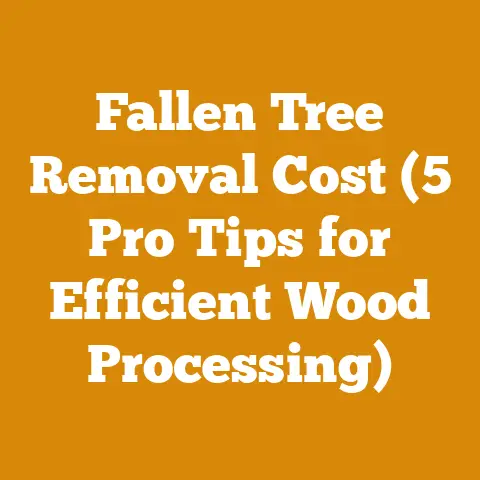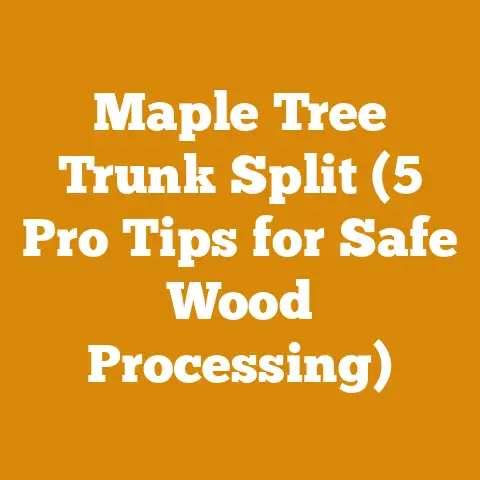Chainsaw Firewood Length Guide (5 Pro Tips for Perfect Bucking)
Chainsaw Firewood Length Guide: 5 Pro Tips for Perfect Bucking
Bucking, the process of cutting felled trees into manageable lengths for firewood, is a critical step in firewood preparation. The length you choose impacts everything from ease of splitting to the efficiency of your wood stove. Here are five pro tips to help you achieve the perfect bucking length:
1. Know Your Wood Stove (or Fireplace) Dimensions
This might seem obvious, but it’s the most crucial factor. Before you even think about firing up your chainsaw, measure the firebox of your wood stove or fireplace. You need to know the maximum length of wood it can accommodate.
- Why it matters: Cutting wood too long means it won’t fit, leading to frustrating re-cuts and wasted effort. Cutting it too short means you’re not maximizing the space in your firebox, requiring more frequent loading.
- Pro Tip: Don’t just measure the length; consider the depth and width of your firebox. A log that’s technically the right length might be too thick to fit comfortably.
- Personal Story: I once spent an entire weekend bucking a load of oak, only to discover my stove could only comfortably fit pieces two inches shorter than what I’d cut. A costly and time-consuming mistake!
2. Account for Shrinkage and Clearance
Wood shrinks as it dries. While the amount of shrinkage varies depending on the species, it’s generally safe to assume a 5-10% reduction in length as wood dries.
- How to factor it in: If your firebox is 16 inches deep, don’t cut your wood exactly 16 inches long. Aim for 15 inches to allow for shrinkage and easy loading.
- Clearance is key: You also need to factor in clearance for easy loading and air circulation. A tightly packed firebox doesn’t burn efficiently.
- Data Point: According to the USDA Forest Service, some hardwoods can shrink up to 8% in length during the drying process.
- Pro Tip: When in doubt, err on the side of shorter. It’s always easier to add a smaller piece of wood than to try and cram in something too long.
3. Consider Splitting Method and Equipment
The length of your firewood also impacts how easy it is to split. Short, thick rounds are often more difficult to split than longer, thinner ones.
- Manual splitting: If you’re splitting by hand with a maul or axe, longer rounds (within reason) provide more leverage and stability.
- Hydraulic splitter: If you’re using a hydraulic splitter, the length is less critical, but you still need to ensure it fits within the splitter’s capacity.
- Log Diameter: The diameter of the log also plays a crucial role. Larger diameter logs generally require a shorter length for easier splitting.
- Pro Tip: For manual splitting, I find that rounds around 16-18 inches offer a good balance between leverage and manageability.
- Personal Story: I remember trying to split some knotty oak rounds that were only 12 inches long. They were incredibly difficult to split, and I wasted a lot of energy.
4. Use a Measuring Tool and Consistent Technique
Consistency is key to efficient firewood preparation. Invest in a simple measuring tool to ensure all your pieces are the same length.
- Simple solutions: A marked stick, a piece of rope, or even a measuring tape can work well.
- Chainsaw technique: Practice making straight, clean cuts. Angled cuts waste wood and can make splitting more difficult.
- Safety First: Always use proper chainsaw safety gear, including eye protection, hearing protection, and chaps.
- Pro Tip: I use a marked stick with different length markings for different stoves and fireplaces. This helps me quickly and accurately cut wood to the right size.
5. Adjust Length Based on Wood Species
Different wood species burn at different rates and have different densities. This can influence the ideal length for your firewood.
- Hardwoods: Dense hardwoods like oak, maple, and hickory burn hotter and longer. You can often use slightly longer pieces.
- Softwoods: Softwoods like pine, fir, and spruce burn faster and produce more smoke. Shorter pieces are often preferred.
- Seasoning Time: The species also influences seasoning time. Hardwoods typically take longer to season than softwoods.
- Data Point: Oak, for example, can take up to two years to properly season, while pine might be ready in six months.
- Pro Tip: I tend to cut softwoods about an inch shorter than hardwoods to compensate for their faster burn rate.
The Hidden Costs of Firewood Preparation: A Data-Driven Approach
Preparing firewood isn’t just about the physical labor; it’s also about the costs involved. Many people underestimate these costs, leading to unexpected expenses and reduced profitability. Let’s break down the various cost components and explore strategies for cost optimization.
1. Timber Acquisition Costs
The cost of acquiring timber is the most significant expense for many firewood producers. This can range from purchasing standing timber to buying pre-cut logs.
- Standing Timber: The price of standing timber varies widely depending on species, location, quality, and volume.
- Pre-Cut Logs: Pre-cut logs are generally more expensive than standing timber, but they save you the time and effort of felling trees.
- Permits and Regulations: In some areas, you may need permits to harvest timber, adding to the overall cost.
- Data Point: According to the Forest Resources Association, the average price of standing timber in the United States can range from \$20 to \$100 per cord, depending on species and location.
- Personal Story: I once tried to harvest timber without the proper permits and ended up facing a hefty fine. It’s always best to do your research and comply with local regulations.
2. Chainsaw and Equipment Costs
Chainsaws are essential tools for firewood preparation, but they also represent a significant investment.
- Chainsaw Purchase: The cost of a chainsaw can range from a few hundred dollars for a basic model to over a thousand dollars for a professional-grade saw.
- Maintenance and Repairs: Chainsaws require regular maintenance, including sharpening, cleaning, and replacing worn parts.
- Safety Gear: Don’t forget the cost of safety gear, including a helmet, eye protection, hearing protection, chaps, and gloves.
- Fuel and Oil: Chainsaws consume fuel and oil, which can add up over time.
- Data Point: A high-quality chainsaw can easily last for 10 years or more with proper maintenance, but cheaper models may only last a few years.
- Pro Tip: Invest in a quality chainsaw from a reputable brand. It will save you money in the long run through reduced maintenance and increased reliability.
3. Splitting Equipment Costs
If you’re splitting wood by hand, you’ll need a maul or axe. If you’re using a hydraulic splitter, you’ll need to factor in the cost of the splitter, fuel, and maintenance.
- Manual Splitting Tools: A good quality maul or axe can cost between \$50 and \$200.
- Hydraulic Splitters: Hydraulic splitters can range from a few hundred dollars for a small electric model to several thousand dollars for a large gas-powered machine.
- Maintenance and Repairs: Hydraulic splitters require regular maintenance, including oil changes and hydraulic hose replacements.
- Data Point: A hydraulic splitter can significantly reduce the time and effort required to split firewood, but it also represents a significant upfront investment.
- Pro Tip: Consider renting a hydraulic splitter if you only need to split wood occasionally. This can save you money on purchase and maintenance costs.
4. Labor Costs
If you’re hiring someone to help you prepare firewood, you’ll need to factor in labor costs.
- Hourly Wages: The hourly wage for firewood preparation labor varies depending on location and experience.
- Worker’s Compensation: You may need to pay worker’s compensation insurance if you’re hiring employees.
- Payroll Taxes: You’ll also need to pay payroll taxes, such as Social Security and Medicare.
- Data Point: The average hourly wage for manual labor in the United States is around \$15 to \$25 per hour.
- Pro Tip: Consider hiring independent contractors instead of employees to reduce your labor costs.
5. Transportation Costs
You’ll need to transport the firewood from the harvesting site to your storage location and then to your customers (if you’re selling it).
- Truck and Trailer: You’ll need a truck and trailer to haul the firewood.
- Fuel Costs: Fuel costs can be significant, especially if you’re hauling firewood long distances.
- Vehicle Maintenance: Your truck and trailer will require regular maintenance, including oil changes, tire rotations, and brake repairs.
- Data Point: The average cost of gasoline in the United States is around \$3 to \$4 per gallon.
- Pro Tip: Optimize your hauling routes to minimize fuel consumption and reduce transportation costs.
6. Storage Costs
Firewood needs to be stored properly to dry and season. This may require building or renting a storage shed or covering the wood with tarps.
- Storage Shed: The cost of building a storage shed can range from a few hundred dollars to several thousand dollars.
- Tarps: Tarps can be a more affordable option for covering firewood, but they need to be replaced periodically.
- Land Rental: If you don’t have enough space on your property, you may need to rent land for firewood storage.
- Data Point: Properly seasoned firewood burns more efficiently and produces less smoke, making it a more desirable product.
- Pro Tip: Choose a storage location that is well-ventilated and protected from rain and snow.
7. Drying Time and Opportunity Cost
Drying firewood takes time, and that time has a cost. While your wood is drying, it’s tying up capital and preventing you from selling it.
- Seasoning Time: Hardwoods typically take 6-12 months to season, while softwoods may only take 3-6 months.
- Capital Tie-Up: The longer it takes to season your firewood, the longer your capital is tied up.
- Opportunity Cost: You could be using that capital for other investments or business opportunities.
- Data Point: Properly seasoned firewood can command a higher price than green firewood.
- Pro Tip: Plan your firewood production cycle well in advance to ensure you have a steady supply of seasoned wood.
8. Marketing and Sales Costs
If you’re selling firewood, you’ll need to factor in marketing and sales costs.
- Advertising: You may need to advertise your firewood in local newspapers, online marketplaces, or social media.
- Delivery Costs: If you’re offering delivery, you’ll need to factor in fuel and labor costs.
- Payment Processing Fees: If you’re accepting credit card payments, you’ll need to pay processing fees.
- Data Point: Online marketplaces like Craigslist and Facebook Marketplace can be effective and affordable ways to market your firewood.
- Pro Tip: Offer discounts for bulk purchases to incentivize customers to buy more firewood.
9. Permitting and Licensing Costs
Depending on your location, you may need permits and licenses to sell firewood.
- Business License: You may need a general business license to operate a firewood business.
- Firewood Vendor Permit: Some areas require a special permit for selling firewood.
- Sales Tax Permit: You’ll need a sales tax permit if you’re collecting sales tax on your firewood sales.
- Data Point: Failure to obtain the necessary permits and licenses can result in fines and penalties.
- Pro Tip: Check with your local government to determine what permits and licenses are required for selling firewood in your area.
10. Contingency Fund
Unexpected costs can arise in any business, so it’s important to have a contingency fund.
- Equipment Breakdowns: Chainsaws and splitters can break down unexpectedly, requiring costly repairs.
- Weather Delays: Inclement weather can delay firewood harvesting and preparation.
- Price Fluctuations: The price of timber and fuel can fluctuate, impacting your profitability.
- Data Point: A contingency fund of 5-10% of your total budget is generally recommended.
- Pro Tip: Regularly review your budget and adjust your contingency fund as needed.
Cost Optimization Strategies for Firewood Preparation
Now that we’ve identified the various cost components, let’s explore strategies for cost optimization.
1. Efficient Timber Harvesting
- Selective Harvesting: Instead of clear-cutting, practice selective harvesting to minimize environmental impact and maximize timber value.
- Utilize Waste Wood: Use waste wood from other projects for firewood.
- Negotiate Prices: Negotiate timber prices with landowners to get the best possible deal.
- Data Point: Sustainable forestry practices can improve timber yields and reduce environmental damage.
2. Proper Chainsaw Maintenance
- Regular Sharpening: Keep your chainsaw chain sharp to reduce fuel consumption and improve cutting efficiency.
- Clean Air Filter: Clean the air filter regularly to ensure proper engine performance.
- Use High-Quality Oil: Use high-quality chainsaw oil to lubricate the chain and prevent wear.
- Data Point: A sharp chainsaw chain can cut up to 20% faster than a dull chain.
3. Efficient Splitting Techniques
- Proper Splitting Technique: Use proper splitting technique to minimize effort and reduce the risk of injury.
- Choose the Right Tool: Choose the right splitting tool for the job. A maul is best for splitting large rounds, while an axe is better for smaller pieces.
- Consider a Hydraulic Splitter: If you’re splitting large volumes of wood, consider investing in a hydraulic splitter.
- Data Point: A hydraulic splitter can significantly reduce the time and effort required to split firewood.
4. Optimize Transportation
- Plan Efficient Routes: Plan your transportation routes to minimize fuel consumption and reduce travel time.
- Maximize Load Capacity: Maximize the load capacity of your truck and trailer to reduce the number of trips.
- Maintain Your Vehicle: Maintain your vehicle to ensure it’s running efficiently and safely.
- Data Point: Proper tire inflation can improve fuel economy by up to 3%.
5. Efficient Storage Practices
- Proper Stacking: Stack your firewood properly to promote air circulation and speed up the drying process.
- Elevate the Wood: Elevate the wood off the ground to prevent moisture from wicking up.
- Cover the Wood: Cover the wood with tarps to protect it from rain and snow.
- Data Point: Properly seasoned firewood burns more efficiently and produces less smoke.
6. Effective Marketing and Sales
- Target Your Audience: Target your marketing efforts to reach your ideal customers.
- Offer Competitive Pricing: Offer competitive pricing to attract customers.
- Provide Excellent Customer Service: Provide excellent customer service to build customer loyalty.
- Utilize Online Marketplaces: Utilize online marketplaces to reach a wider audience.
- Data Point: Word-of-mouth marketing is one of the most effective ways to attract new customers.
Case Study: Budgeting for a Small-Scale Firewood Operation
Let’s consider a case study of a small-scale firewood operation to illustrate the budgeting process.
Scenario: John wants to start a small-scale firewood operation to supplement his income. He plans to harvest timber from his own property and sell the firewood to local customers.
Assumptions:
- John owns 10 acres of forested land.
- He has a chainsaw and a maul.
- He plans to sell 20 cords of firewood per year.
- He will sell the firewood for \$200 per cord.
Budget:
| Expense Category | Estimated Cost |
|---|---|
| Timber Acquisition (own land) | \$0 |
| Chainsaw Maintenance | \$100 |
| Maul Maintenance | \$20 |
| Fuel and Oil | \$200 |
| Transportation | \$300 |
| Storage | \$100 |
| Marketing and Sales | \$50 |
| Permits and Licenses | \$50 |
| Contingency Fund (5%) | \$41 |
| Total Expenses | \$861 |
Revenue:
| Revenue Source | Estimated Income |
|---|---|
| Firewood Sales (20 cords) | \$4,000 |
Profit:
- Profit = Revenue – Expenses = \$4,000 – \$861 = \$3,139
Analysis:
Based on these assumptions, John can expect to make a profit of \$3,139 per year from his small-scale firewood operation. This budget does not include John’s labor, which he is contributing.
Recommendations:
- John should track his expenses carefully to ensure he stays within budget.
- He should consider investing in a hydraulic splitter to increase his production capacity.
- He should explore opportunities to sell his firewood at a higher price.
Actionable Takeaways and Next Steps
Preparing firewood and managing the associated costs can be a challenging but rewarding endeavor. By following the pro tips outlined in this guide and implementing effective cost optimization strategies, you can increase your efficiency, reduce your expenses, and maximize your profitability.
Next Steps:
- Assess your needs: Determine the ideal firewood length for your stove or fireplace.
- Develop a budget: Create a detailed budget that includes all the cost components discussed in this guide.
- Implement cost optimization strategies: Implement cost optimization strategies to reduce your expenses.
- Track your progress: Track your progress regularly to ensure you’re on track to meet your goals.
- Continuously improve: Continuously improve your processes and techniques to increase your efficiency and profitability.
Remember, the key to success in firewood preparation is planning, preparation, and a commitment to continuous improvement. With the right knowledge and tools, you can enjoy the warmth and comfort of a wood fire while also managing your costs effectively. So, get out there, fire up your chainsaw, and start preparing for a cozy winter!






